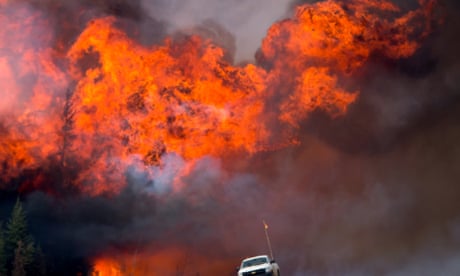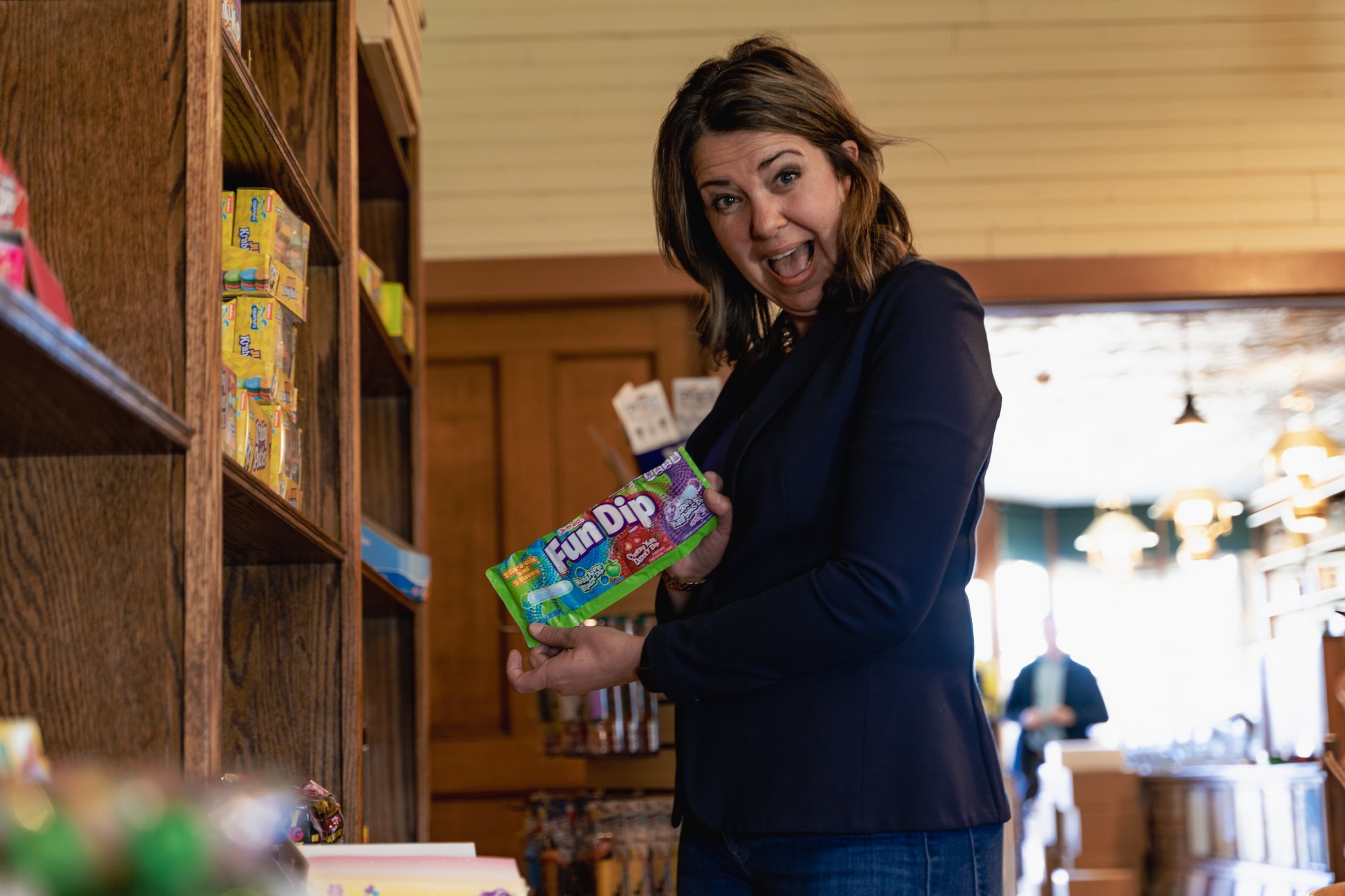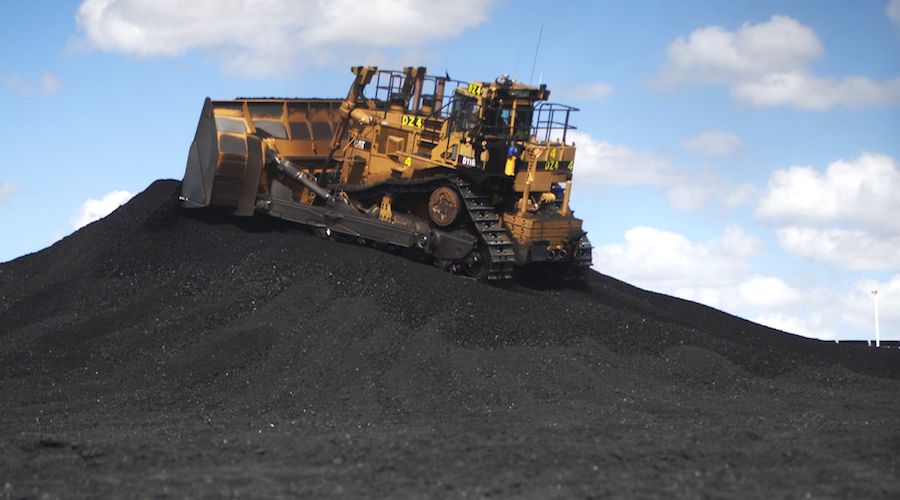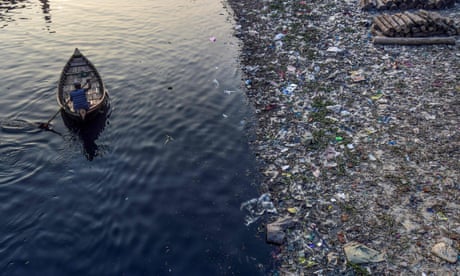
Monday’s election is going to be a political nail-biter but neither candidate has discussed a post oil and gas world
Record-breaking wildfires have charred more than a million hectares of land in Alberta, pushing tens of thousands from their homes and choking the skies in a thick haze of smoke.
But on the zigzagging campaign trail of the province’s general election, neither party leader has confronted the realities of climate change and how it will likely dramatically reshape life in the Canadian prairies.
Instead, they’ve spent weeks sparring over taxation, health care – and one candidate’s deeply offensive remarks about transgender children.
By all accounts, Alberta’s election on Monday is going to be a political nail-biter, a bitterly contested campaign filled with fears of party mutiny, allegations of judicial interference and an unprecedented political comeback.
But for all the excitement of the race, political scientists are baffled that leaders have repeatedly shied away from confronting the realities of global heating.

‘Like Nagasaki’: devastating wildfires will only get worse, new book warns
“All you need to do is go outside to see what climate change is like and what the effects are, with people fleeing their homes from wildfires,” said Feodor Snagovsky, a professor of political science at the University of Alberta. “The fact that we haven’t talked about it at all during this election cycle is simply flabbergasting. It’s incongruous with reality.”
The province has some of the most abundant oil reserves in the world, the vast majority of which are locked up in bituminous sands. For decades, Alberta’s prosperity has been tied to the vast oil sands mining operations, contributing billions to provincial revenues.
But Snagovsky believes voters in the province already recognize that the world is moving away from fossil fuels.
“Still, it’s going to take some time for people to really reconcile that. It’s difficult to imagine living in a future that doesn’t include the oil and gas industries,” he said, adding that political leaders need to have “adult conversations” with voters about a post oil and gas world.
The tight nature of the race has meant both parties have been silent on the relationship between climate change and the oil and gas industry in the region, despite a recent paper explicitly linking the two.
Instead, incumbent premier Danielle Smith of the United Conservative Party (UCP) who has spent months casting herself as Ottawa’s greatest foe, has focused her campaign on the mounting affordability crisis, and pledged to renew her fight against carbon taxes, which she argues hurt ordinary Albertans.
But the UCP, the result of an uneasy pact between fiscal conservatives and a hard-right faction, has struggled to focus on economic messaging amid a flood of controversies.
Smith, who took power after her predecessor Jason Kenney abruptly resigned, was the subject of a damning report by Alberta’s ethics commissioner, which found she broke the province’s Conflicts of Interest Act when she spoke with a homophobic street preacher facing criminal charges, and warned that her actions represented a “threat to democracy”.
That warning came after audio leaked of UCP legislative assembly candidate Jennifer Johnson comparing transgender school students to feces in cookie dough.
Johnson apologized and Smith called the analogy “vile”, warning Johnson would not sit in the UCP caucus if she wins. Smith then walked back that idea, suggesting Johnson could join the caucus if she could “redeem” herself, but was then forced to once again say Johnson wouldn’t be welcomed back.
The close race marks a departure from decades of rule by successive conservative governments and speaks to the chaotic nature of Smith’s tenure, said Duane Bratt, a professor of political science at Mount Royal University in Calgary.
“We’ve had elections, but we really had dynasties lasting decades. In theory, this race shouldn’t be close. If there was a normal incumbent UCP leader, they would be winning re-election quite easily. So much of this is about the lack of trust and questions over the judgment and competency of Danielle Smith.”
Rachel Notley, the former premier whose New Democrats won a surprise majority in 2015, is hoping to capitalize on that weakness – and to make provincial history by winning another term. Notley has remained popular within her own party and remains within striking distance of a second term as premier.
Notley, who as premier unveiled ambitious environmental policies, has also remained silent on climate change, instead running a campaign largely focused on rebuilding the province’s battered health care system, which was strained under the coronavirus pandemic and faces cuts and the prospect of privatization of certain medical procedures. She has also worked to lure in disaffected conservatives, promising balanced budgets to placate worries her government isn’t fiscally responsible.
Rural Alberta remains firmly conservative, but fierce electoral battles are being fought for urban centres. The NDP is poised to perform strongly in Edmonton, the province’s second largest city, meaning the result in Calgary will determine who forms the provincial government.
To win, the NDP needs to convince Albertans who have voted conservative for most of their life to switch parties – a feat that would have been nearly impossible without the recent scandals around the UCP, says Bratt. In a province that has never had a minority government – or even a close election –pollsters have largely given up trying to predict a winner.
The stakes are high for Notley, whose political future looks uncertain unless she can steer her party to victory. But analysts have also speculated that even with a decisive victory, Smith could be forced out by her own party. In nearly two decades, no conservative premier has served a full term in office, said Bratt, adding that no electoral victory has been enough to stave off disgruntled factions.
“This election has big implications for the province and for Canada,” he said. “I don’t think the drama ends on Monday night.”

It’s understandable that UCP Leader Danielle Smith avoids mentioning climate change as much as possible. File photo
As a yellow haze enshrouded Calgary, I wondered if the wildfire smoke would have any impact on the May 29 provincial election. For many years, climate scientists have been predicting an increase in the frequency and severity of extreme heat, drought and forest fires. The cause is global warming due to the burning of fossil fuels and people are beginning to understand that the consequences are serious. Evacuations, destroyed homes and massive air pollution are unsettling and all too familiar.
Will a dry spring coupled with heat dome temperatures at twice the springtime average be enough for Albertans to consider climate as they go to the polls? Will the acrid smell of trees burning hundreds of kilometres to the north give people pause as they consider voting for pipelines and starting a protracted fight against the federal government’s policies to address the climate crisis?
The United Conservative Party (UCP) has always presented itself as a defender of the oil and gas industry, something that resonates powerfully among the many Albertans employed in the sector. However, Danielle Smith’s campaign is toned down in comparison to former premier Jason Kenney’s rants against the foreign and internal enemies of Alberta’s most important industry
There’s been an obvious shift in sentiment among both politicians and voters. Smith isn’t driving around the campaign trail in the largest pickup truck on the market and the streets of Calgary’s neighbourhoods are noticeably absent of the “I Love Alberta Oil and Gas” signs that littered many lawns in the last election. What was a sea of blue UCP lawn signs four years ago is now balanced and often exceeded by the New Democratic Party (NDP) orange.
It’s understandable that Smith avoids mentioning climate change as much as possible. Why would she talk about a problem when the solution involves reducing and eventually eliminating the global use of fossil fuels? NDP Leader Rachel Notley must also be careful not to campaign too loudly on policies that prepare Alberta for the inevitable global energy transition. Notley is trying hard to avoid being labelled as an enemy of the petro-state
Notley has suffered attack ads over her commitment to a net-zero electrical grid by 2035, in which the UCP has confabulated an astronomical price tag for this election promise.
Smith’s minister of Jobs, Economy and Northern Development and former Wildrose party leader, Brian Jean, has attempted to misconstrue Notley’s support for a greenhouse gas (GHG) emissions cap as a plan to cap oil and gas production. UCP strategists see any commitment to addressing climate change as a weakness in the opposition that can be exploited with a healthy dose of exaggeration.
According to a recent Abacus Data poll, climate change is well down on the list of election priorities. The cost of living, health care, the economy and keeping taxes low are far greater concerns, while climate change and defending the oil and gas industry are roughly equivalent priorities for voters. Climate change is clearly a sensitive issue that both the NDP and UCP would prefer not to focus on.
Looking at the poll numbers, I have to conclude the apocalyptic haze that descended on Calgary will change very few minds. I believe that renewing and cleaning up our electrical grid makes sense when the province has abundant wind and solar resources, but there are a lot of Albertans who think Smith’s dream of building a pipeline to Hudson’s Bay is the best investment for our children’s future.
The provincial campaign is being fought over many issues, but climate change is the elephant in the room, @winexus writes. #abVote #ClimateCrisis
Economists believe “a carbon tax offers the most cost-effective lever to reduce carbon emissions at the scale and speed that is necessary.” I particularly like the fact that the federal carbon tax is rebated to Albertans and actually rewards people who own energy-efficient cars and homes.
Other people in my province hate taxes and are OK with oil companies that don’t pay their taxes. A recent Rural Municipalities Association member survey showed that rural municipalities collectively face an unpaid property tax burden of $268 million from oil and gas companies, which represents a six per cent increase from last year.
The Alberta election is being fought over many issues, but climate change is the elephant in the room. The UCP will set Alberta on a collision course with the inevitable impacts of climate change. They will invest heavily in oilsands production, industry propaganda and dubious technologies like carbon capture and storage. They will be unsupportive of anything that reduces demand for fossil fuels, such as renewable energy, electrification and energy-efficient buildings.
The NDP will plan for an energy transition, diversify the economy and start building a net-zero electrical grid. Notley introduced the “off coal” policy that was designed to eliminate coal-fired electricity generation in Alberta by 2030. The policy was so effective that the goal will be achieved this year. The NDP has demonstrated trustworthy leadership in achieving GHG emissions reductions and is promising to do more if elected.
The choice for Albertans is very clear and will shape the future success of our province. Voters appear to be split down the middle, with half still dreaming of the promise of an “energy superpower” that brings wealth for decades to come.
The other half thinks a different kind of future is possible and is very worried about how unabated global warming will affect the lives of future generations. It remains to be seen if the latest environmental disaster that is polluting the skies of Alberta will tip the scales in favour of a better future.
Rob Miller is a retired systems engineer, formerly with General Dynamics Canada, who now volunteers with the Calgary Climate Hub and writes on behalf of Eco-Elders for Climate Action.
By Max Fawcett | Opinion, Politics |

Is Alberta's wild ride with Danielle Smith as premier coming to an end on Monday — or just getting started? Photo by Government of Alberta / Flickr (CC BY-NC-ND 2.0)
Based on the flurry of recent polls that show Danielle Smith’s United Conservative Party either in the lead or close to it, the answer will almost certainly be “too much.” This shouldn’t be too surprising given the well-documented fondness in Alberta for not paying taxes and the NDP’s curious decision to announce a tax hike as one of its key platform commitments. This fed into the pre-existing narrative — one the NDP has done almost nothing to complicate — about the party’s general hostility to business and the economy, facts be damned. To revive James Carville’s famous slogan from the 1992 Democratic presidential campaign: it’s still the economy, stupid.
This is understandably frustrating for anyone with a conception of politics that extends beyond their own bank balance. Smith has allied herself with people like Artur Pawlowski, whose long track record of anti-LGBTQ comments includes a recent sermon where he told supporters of abortion and trans rights that he would “hunt you, every step of the way.” She has attracted candidates who compare trans kids to fecal matter and insist schools are showing children pornography in classrooms. And perhaps most infamously, she has compared vaccinated Albertans to supporters of Nazi Germany and Adolf Hitler.
She’s also surrounded by powerful backroom operatives and activists who push things even further than she does. David Parker, the home-schooled leader of Take Back Alberta, has said that “a small fringe minority with unacceptable views has taken over all of your institutions, your legal system, your medical system (and) your education system. They’ve taken over your churches, to some degree.” Ironically, he’s not referring to his own supporters, who believe and say things that clearly place them at the ideological margins of Alberta society. Parker, for example, thinks women who put their careers before having kids are part of a “war between the pro-humans and anti-humans.”
We’ve seen this movie before, of course, with Donald Trump. He was objectively worse than Smith, who at least believes in things like a woman’s right to choose and the LGBTQ community’s right to exist. Trump’s supporters, meanwhile, threatened (and then committed) the sort of rhetorical and literal violence that still remains — for now, at least — offside here in Canada. Americans, to their everlasting discredit, elected him once, almost re-elected him in 2020 and may well return him to office in 2024. For all the right’s self-serving mewling about cancel culture, we clearly live in a world where saying and believing objectively terrible things is not automatically disqualifying — especially if you're promising to cut taxes for rich people.
The same seems to hold true in Alberta. Some voters will try to look past that uncomfortable truth, just as millions of Republicans did with Trump’s racism, homophobia and anti-science ramblings. They’ll focus on things like the tax cuts, smaller government and other ideological hobby horses. They’ll tell themselves (as some UCP campaigners have been telling them, apparently) that Smith will be gone in short order anyways, replaced by a leader who can more reliably advance their economic interests without stirring up a shitstorm in the process.
This is, to be kind, a bit naive. To be less kind, it’s completely delusional. Once you validate this sort of casual cruelty, it only invites and endorses more of it. These voters need only watch Pawlowski’s press conference from Wednesday when he stood on the steps of the legislature and railed against the LGBTQ community and the UCP’s apparent betrayal of his interpretation of reality. They should think hard on why Smith thought it was a good idea to meet with this man, much less promise him the things he claims to have been offered. And they should ask themselves: when push comes to shove (and it always does lately with conservative leaders in Alberta), who do they think Parker and Take Back Alberta will side with?
In time, Smith may have to apologize for inviting that element into the conservative coalition and handing it the reins of power. But as we’ve seen with Trumpism’s continued destruction of America’s political landscape, by the time those apologies are made, it’s already far too late to do much about it. We have one chance to stop that from happening here in Alberta. Let’s hope the voters use it.
Posted on May 27th, 2023

Final 2023 Alberta Election Poll: Before the Election – May 27, 2023
DOWNLOAD THE REPORT
Leger recently surveyed Albertans about Alberta politics and their final voting intentions for the 2023 Alberta election poll: before the election.
SOME OF THE KEY FINDINGS OF OUR SURVEY ON THE 2023 ALBERTA ELECTION POLL:
56% of decided voters in Edmonton are more likely to vote NDP, while those living outside of Edmonton or Calgary are more likely to vote UCP (60%).
55% of Albertans aged 55+ are more likely to vote UCP, while 56% of those aged between 18 and 34 are more likely to vote NDP.
76% of Albertans who will vote for a listed party have made a final decision for who to vote for. 21% indicate that they may change their mind.
80% of decided NDP voters have made a final decision as to who they will vote for.
38% of Albertans feel Danielle Smith and the UCP will win the next provincial election and form the next government.
SURVEY METHODOLOGYA total of n=1,011 online surveys were conducted among Albertans aged 18 or older via Leger’s LEO panel.
The survey was conducted from May 23 to 25, 2023, using computer-assisted web interviewing (CAWI) technology.
Using data from the 2021 Census, the results were weighted according to age, gender, and region in order to ensure a representative sample of the population.
As a non-random internet survey, a margin of error is not reported. If the data were collected through a random sample, the margin of error for a sample size of n=1,011 would be ±3.1%, 19 times out of 20.
CBC News poll suggests United Conservative Party headed for victory in Alberta
UCP leads province-wide, but race remains competitive in battleground Calgary, according to CBC News poll
After trailing in the polls for years, the United Conservative Party appears poised to win a majority next Monday, according to a new CBC News poll.
"If you asked me four months ago how I thought this election was going to turn out, I'd say the NDP was going cruise to victory," said Calgary-based pollster Janet Brown, who conducted the random survey of 1,200 Alberta voters.
Brown thinks the ruling UCP turned things around with their big-spending campaign promises, beginning in early April.
But Calgary remains competitive — and at least one longtime political watcher says it's too early to count out the NDP.
UCP holds big lead outside Alberta's two biggest cities
The UCP leads province-wide with 52 per cent amongst decided or leaning voters, followed by the NDP at 44 per cent.
One in five voters surveyed in the random poll conducted between May 12 -24 are still deciding how they will vote in Alberta's general election on Monday.
A survey of Alberta voters last fall found that 51 per cent of women intended to vote NDP, compared to 43 per cent of men.
Men remain more likely to vote for the UCP — but women appear evenly split between the two parties in this most recent poll.
Using CBC News' polling results, Brown predicts the UCP is likely to capture 51 of the 87 seats in Alberta's Legislative Assembly.
In the May 2019 election, the United Conservative Party — a merger of the Wildrose Party and Progressive Conservative Association in 2017 — grabbed 55 per cent of the popular vote and 63 seats in the legislature. The NDP won 24 seats, mostly in Edmonton.
Smith and Notley have identical approval ratings
While most Albertans seem to prefer the UCP over the NDP, voters in the Prairie province appear to have identical impressions of the two parties' leaders.
Nearly half of Albertans (47 per cent) somewhat or strongly disapprove of both the UCP's Danielle Smith and the NDP's Rachel Notley.
The two leaders vying for the province's top job each received identical 42 per cent approval ratings.
Smith's campaign attracted a lot of controversy.
Last week, the province's ethics commissioner concluded that Smith breached Alberta's conflict of interest law.
The UCP leader also took heat earlier in the campaign for suggesting those who got vaccinated against COVID-19 fell for the "charms of a tyrant" specifically referencing Adolf Hitler.
And the NDP repeatedly hammered Smith throughout the campaign for her previous support for paying out-of-pocket for doctor visits.
Brown thinks the NDP's relentless focus on Smith's competence and trustworthiness backfired.
She thinks many Alberta voters got turned off by the negative tone of the campaign.
"I think by focusing so much on Smith, [the NDP] gave people a reason to doubt Smith and her competence as leader, but they didn't do enough to give people an affirmative reason to vote for the NDP," said Brown.
"The NDP had a campaign that only had one note," added Brown. "As the election campaign ground along, Albertans became more comfortable with Smith and less comfortable with Notley."
Longtime Alberta political watcher Duane Bratt echoes Brown, stressing that the NDP's attack ads likely overwhelmed voters.
"It's been a very negative campaign," said the political scientist with Mount Royal University's economics, justice, and policy studies department.
Bratt thinks some NDP punches — including Smith's controversial Hitler and poppy comments — landed with voters.
But Bratt thinks a lot of the negative campaign became noise that voters tuned out.
"They've thrown everything out, every video that they have.… If you throw everything at it, it seems like it's a piling on," said Bratt in an interview with CBC News.
Poll shows battleground Calgary remains close
The horse race between the UCP and NDP remains tight in Calgary
The UCP leads amongst deciding and leaning voters with 49 per cent in Alberta's largest city. The NDP remains competitive with 46 per cent.
Bratt thinks lingering concerns in Calgary voters' minds about the UCP leader could still help New Democrats.
"I think they have a sliver of hope because there remain doubts about Smith," said Bratt.
Bratt wonders if these misgivings will translate into traditional conservative voters staying home. He recalls the 2012 election where public opinion polls suggested Smith — then leader of the Wildrose Party — would win but the Progressive Conservatives came from behind to win a majority.
Conservatives are a constant in Calgary.
The city has — for decades — reliably elected conservatives provincially and federally.
The economy has rebounded, but doubts persist in Calgary voters' minds about Smith, says Bratt.
"The UCP should win and should win quite handily," he said. "The fact that they're not is because of Danielle Smith."
CBC News' random survey of 1,200 Albertans was conducted using a hybrid method between May 12 and 24 by Edmonton-based Trend Research under the direction of Janet Brown Opinion Research. The sample is representative of regional, age and gender factors. The margin of error is +/- 2.8 percentage points, 19 times out of 20. For subsets, the margin of error is larger.
The survey used a hybrid methodology that involved contacting survey respondents by telephone and giving them the option of completing the survey at that time, at another more convenient time, or receiving an email link and completing the survey online. Trend Research contacted people using a random list of numbers, consisting of both landlines and cellphone numbers. Telephone numbers were dialed up to five times at five different times of day before another telephone number was added to the sample. The response rate was 5.35 per cent.







